The Intel Broadwell Xeon E3 v4 Review: 95W, 65W and 35W with eDRAM
by Ian Cutress on August 26, 2015 9:00 AM ESTGaming Benchmarks: Low End
To satisfy our curiosity regarding high power and low power eDRAM based Xeons in gaming, we ran our regular suite through each processor. On this page are our integrated graphics results, along with a cheaper graphics solution in the R7 240 DDR3.
Alien: Isolation
If first person survival mixed with horror is your sort of thing, then Alien: Isolation, based off of the Alien franchise, should be an interesting title. Developed by The Creative Assembly and released in October 2014, Alien: Isolation has won numerous awards from Game Of The Year to several top 10s/25s and Best Horror titles, ratcheting up over a million sales by February 2015. Alien: Isolation uses a custom built engine which includes dynamic sound effects and should be fully multi-core enabled.
For low end graphics, we test at 720p with Ultra settings, whereas for mid and high range graphics we bump this up to 1080p, taking the average frame rate as our marker with a scripted version of the built-in benchmark.


Total War: Attila
The Total War franchise moves on to Attila, another The Creative Assembly development, and is a stand-alone strategy title set in 395AD where the main story line lets the gamer take control of the leader of the Huns in order to conquer parts of the world. Graphically the game can render hundreds/thousands of units on screen at once, all with their individual actions and can put some of the big cards to task.
For low end graphics, we test at 720p with performance settings, recording the average frame rate. With mid and high range graphics, we test at 1080p with the quality setting. In both circumstances, unlimited video memory is enabled and the in-game scripted benchmark is used.
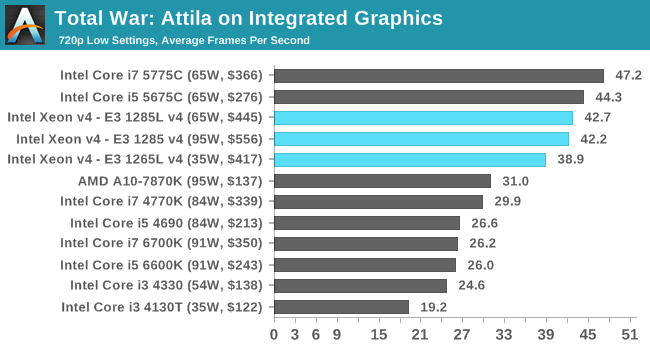
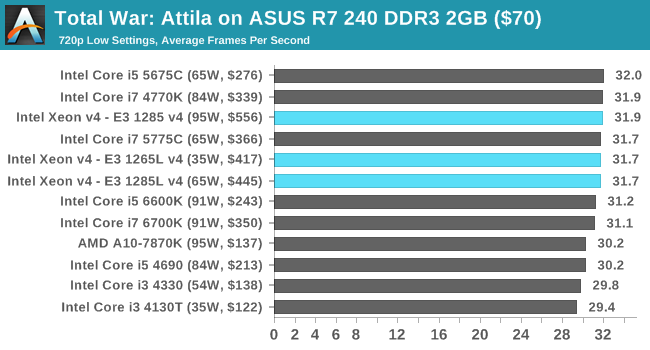
Grand Theft Auto V
The highly anticipated iteration of the Grand Theft Auto franchise finally hit the shelves on April 14th 2015, with both AMD and NVIDIA in tow to help optimize the title. GTA doesn’t provide graphical presets, but opens up the options to users and extends the boundaries by pushing even the hardest systems to the limit using Rockstar’s Advanced Game Engine. Whether the user is flying high in the mountains with long draw distances or dealing with assorted trash in the city, when cranked up to maximum it creates stunning visuals but hard work for both the CPU and the GPU.
For our test we have scripted a version of the in-game benchmark, relying only on the final part which combines a flight scene along with an in-city drive-by followed by a tanker explosion. For low end systems we test at 720p on the lowest settings, whereas mid and high end graphics play at 1080p with very high settings across the board. We record both the average frame rate and the percentage of frames under 60 FPS (16.6ms).


GRID: Autosport
No graphics tests are complete without some input from Codemasters and the EGO engine, which means for this round of testing we point towards GRID: Autosport, the next iteration in the GRID and racing genre. As with our previous racing testing, each update to the engine aims to add in effects, reflections, detail and realism, with Codemasters making ‘authenticity’ a main focal point for this version.
GRID’s benchmark mode is very flexible, and as a result we created a test race using a shortened version of the Red Bull Ring with twelve cars doing two laps. The car is focus starts last and is quite fast, but usually finishes second or third. For low end graphics we test at 1080p medium settings, whereas mid and high end graphics get the full 1080p maximum. Both the average and minimum frame rates are recorded.
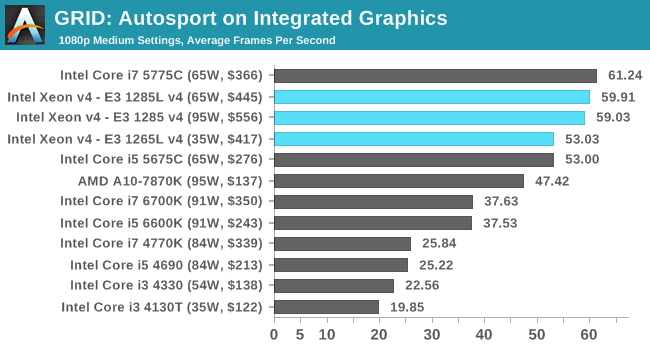
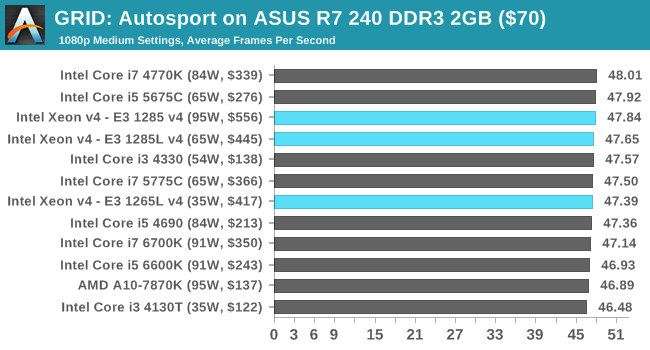
Middle-Earth: Shadow of Mordor
The final title in our testing is another battle of system performance with the open world action-adventure title, Shadow of Mordor. Produced by Monolith using the LithTech Jupiter EX engine and numerous detail add-ons, SoM goes for detail and complexity to a large extent, despite having to be cut down from the original plans. The main story itself was written by the same writer as Red Dead Redemption, and it received Zero Punctuation’s Game of The Year in 2014.
For testing purposes, SoM gives a dynamic screen resolution setting, allowing us to render at high resolutions that are then scaled down to the monitor. As a result, we get several tests using the in-game benchmark. For low end graphics we examine at 720p with low settings, whereas mid and high end graphics get 1080p Ultra. The top graphics test is also redone at 3840x2160, also with Ultra settings, and we also test two cards at 4K where possible.
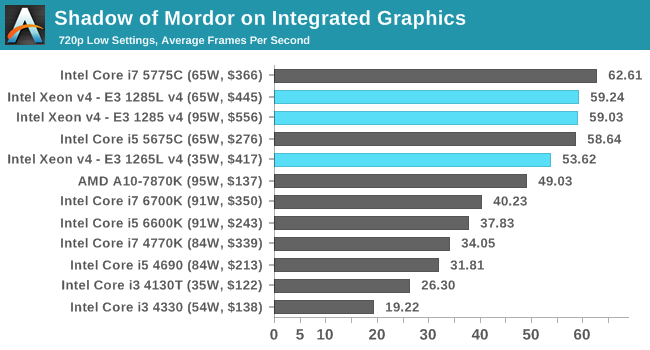
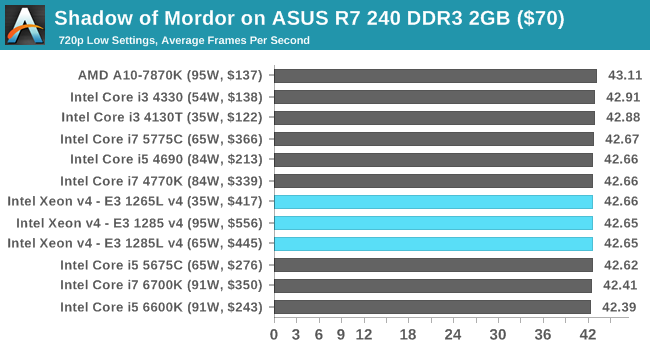















72 Comments
View All Comments
lilmoe - Wednesday, August 26, 2015 - link
+1I'm looking forward to the new mobile Xeon chips and would love to see that too.
Ian Cutress - Thursday, August 27, 2015 - link
Working on it! :)satai - Friday, August 28, 2015 - link
Great to hear that.Atari2600 - Wednesday, August 26, 2015 - link
Ian,Primarily in the graphs you compare a 1276 v3 to two flavours of 1285 v4.
But, on the first page, you tabulate the 1285 v3 and 1265 v3.
Would it be possible to include the 1276 v3 in this table?
Just quickly looking at ark.intel; the 1276 v3 has a box price of $350 and seems otherwise identical to the 1285 v3. On the face of it, it appears a disruptor.
Cheers
Brendan
lilmoe - Wednesday, August 26, 2015 - link
That's one hell of a 35W chip. Not bad at all.jamyryals - Wednesday, August 26, 2015 - link
Why does the 95Watt part exist? I don't get it.Gigaplex - Wednesday, August 26, 2015 - link
And why does the 65W chip consume more power than the 95W one?Oxford Guy - Wednesday, August 26, 2015 - link
Because Intel's power consumption ratings are a load of nonsense often enough. And AMD isn't always accurate either. The 8320E, for instance, is rated 95W but actually used 86 in Anandtech's tests. The 8370E is rated 95W but used 107 or something. The 9590 is even further away from its rating.But, Intel is the one gaining the most from this deceptive marketing since people know AMD's FX chips are power-hungry due to being on 32nm and not having had as much money invested in hand-tuning to lower power. So, Intel underestimates the consumption of parts like the 4790K to make its chips seem even more dramatically efficient.
Yuriman - Thursday, August 27, 2015 - link
There's one problem with this: TDP is not "power consumption", but "Thermal Design Power". A chip with a 95w TDP needs to function in an environment designed to dissipate 95w of heat over a given period of time. CPUs can go well over this for short periods.Oxford Guy - Thursday, August 27, 2015 - link
Short periods are one thing. False advertising is another.